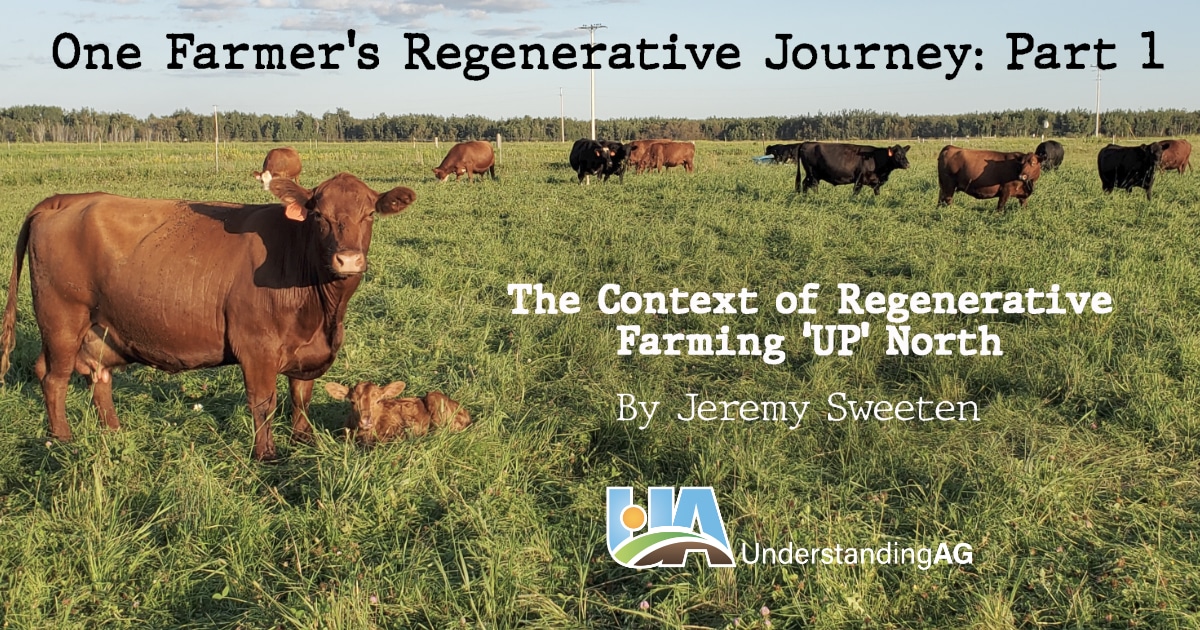
Understanding Ag is dedicated to teaching and helping its clients understand and successfully apply the Six Principles of Soil Health™ Based on my experience, the most important of those is the principle of “context.” This is the how, why and for what reason a farm/ranch does what it does. Context is also a way of explaining future goals. In this series of articles, I will walk through how we are implementing the Six Principles of Soil Health™ on our beef and hay farm and how those principles provide the pathway for our regenerative farming journey.
The following narrative describes our context, explains how we began and how we are advancing in regenerative agriculture.
In the beginning
In 2015, my wife and I moved four children from our farm in northern Indiana to a new farm in the eastern Upper Peninsula of Michigan. It was an awesome opportunity for us, even with an average snowfall of 120 inches per year, because this was the beginning of our travels down the regenerative farming path. There was the incredible excitement of a new farm with new challenges and environment. The beauty of a clean slate was almost surreal because we could farm the way we wanted, but I’m not sure that we really knew what we wanted, other than to survive.
Our farm was previously a rotationally grazed dairy farm until 2001 and then it was hayed for the next 14 years. It consists of flat, poorly drained, red clay soils that grew predominantly Timothy, birdsfoot trefoil, red clover, and quackgrass and soil organic matter ranged from 3.5-6.5%. In the beginning, I knew very little about assessing soil biology to really gauge the health of our soils. The county hay average for one cutting per year was about 1.5 T/A. The average precipitation is 33 inches per year and the average growing season is 120 days. The spring frost date is May 17 and fall frost date is October 5.
Not knowing what else to do in 2015, we harvested our home farm as dry hay to market as big square bales of horse hay. In the back of my mind, I really wanted to add cattle to help mitigate risk and add another source of income and in 2016, we had the opportunity to custom raise grass-fed beef stockers for the summer, spending some days building high tensile fence a day ahead of the stockers. Still, we did not realize what we were about to learn.
Seeing the changes
By 2017, we were seeing a positive response to rotationally grazing the pastures with stockers including more plant diversity, healthier plants, and better cattle performance. We built more perimeter fence and soon had 100 acres of our tillable ground fenced in, renting another 200 acres of fenced pasture from the neighbor. We also began custom grazing 40 cow/calf pairs.
In 2018, instead of taking delivery of stockers each spring, we took delivery of cow/calf pairs. Our goal was to wean the calves each spring and raise the calves as stockers to ship in the fall. Once again, the increased number of animals had more impact on our ground.
Fast forward to 2021, when we bought 90 cows and kept our calves back to raise as stockers. Having cow/calf pairs on the farm allowed us to have an immense impact on soil health and pasture performance and the use of bale grazing allowed us to have animal impact on our farm, even with snow on the ground.
More advances as the journey continues
Currently, we are running 90-100 cow/calf pairs and 80-90 stockers, grass fed and chemical free. We keep all our own replacement heifers out of the stocker group,have fenced in another 100 acres and no longer hay our farm. In our farming model, each purchased bale is a net import of nutrients, carbon, and diversity. Importantly, we now have a goal and a long-term plan to graze adaptively and regenerate the soils on our farm.
In the next article, I will discuss in more detail how we have used more of the Soil Health Principles to grow healthier soil, plants, animals and profits.
